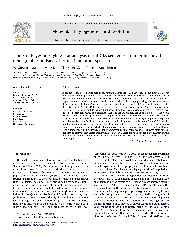摘要
A previous analysis of Pacific herring mitochondrial (mt) DNA with Bayesian skyline plots (BSPs) was interpreted to reflect population growth in the late Pleistocene that was preceded by population stability over several hundred thousand years. Here we use an independent set of mtDNA control region (CR) sequences and simulations to test these hypotheses. The CR haplotype genealogy shows three deeply divided lineages, A, B and C, with divergences ranging from d = 1.6% to 1.9% and with similar genetic diversities (h = 0.95, 0.96, 0.94; Theta(n) = 0.011, 0.012, 0.014, respectively). Lineage A occurs almost exclusively in the NW Pacific and Bering Sea, but lineages B and C are co-distributed in the Northeastern Pacific. This distribution points to a historical allopatric separation between A and B-C across the North Pacific during Pleistocene glaciations. The origins of B and C are uncertain. One hypothesis invokes long-term isolation of lineage C in the Sea of Cortez, but the present-day lack of geographical segregation from lineage B argues for lineage sorting to explain the deep divergence between B and C. BSPs depict rapid population growth in each lineage, but the timing of this growth is uncertain, because of questions about an appropriate molecular clock calibration. We simulated historical demographies under a Pleistocene climate model using observed genetic parameters. BSPs for these sequences showed rapid population growth after the Last Glacial Maximum (LGM) 18-20k years ago and a flat population history during previous climate fluctuations. Population declines during the LGM appear to have erased signals of previous population fluctuations.
- 出版日期2012-10
- 单位中国海洋大学
